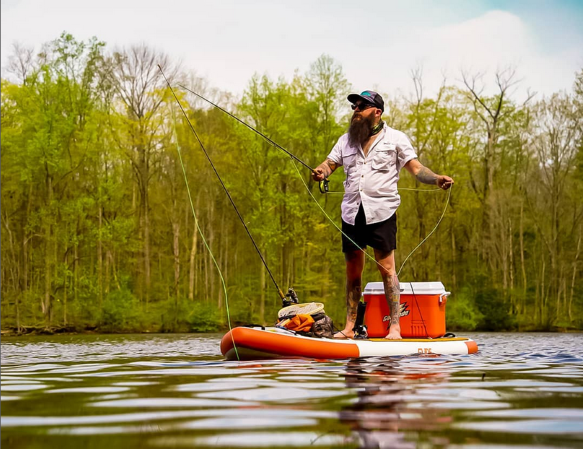
Paddle Board Fishing: A Comprehensive Guide
Are you on the hunt for a fresh and exhilarating way to fish? Look no further than paddle board fishing! This guide dives into the rich history, myriad benefits, essential gear, and practical tips for embarking on your paddle boarding adventure.

Key Highlights
- Origins of Paddle Board Fishing: Tracing back to ancient Polynesian culture, paddle board fishing has evolved into a popular modern sport, enhanced by specialized SUPs designed for angling.
- Benefits of Paddle Board Fishing: Offers a full-body workout, unparalleled accessibility to various water bodies, a stealth approach to getting closer to fish, and an eco-friendly alternative to traditional fishing methods.
- Essential Gear: A fishing-ready paddle board with stability and ample storage, paddle, life jacket, fishing equipment, and necessary accessories for comfort and safety.
- Pro Tips for Success: Start in calm waters, secure your board, stay weather aware, comply with local fishing laws, and practice catch and release to support sustainable fishing practices.
- FAQs: Addressing common questions about using regular SUPs for fishing, licensing requirements, safety, fishing locations, optimal fishing times, and recommended equipment.
The Origins of Paddle Board Fishing
Paddle boarding, a staple in ancient Polynesian culture, has evolved into a beloved sport across the globe. Originating as a method for navigating shallow waters in pursuit of fish, today's paddle board fishing incorporates specialized SUPs, gear, and accessories, making it a versatile choice for anglers everywhere. Glide's inflatable SUP, renowned for its ample storage and seamless integration with fishing needs, stands out as a top pick for enthusiasts.

Why Choose Paddle Board Fishing?
Opting for a SUP for your fishing expeditions offers unparalleled benefits:
- Full-Body Workout: Engage multiple muscle groups while improving balance and coordination.
- Accessibility: From calm lakes to the open sea, SUP fishing is versatile.
- Stealth Approach: Glide silently, getting closer to fish without alarming them.
- Eco-Friendly: Paddle boards require no fuel, making them a green option.

Essential Gear for Paddle Board Fishing
To get started, you'll need:
- A Fishing-Ready Paddle Board: Look for stability, space for gear, and enhanced durability.
- Paddle: Propel yourself with ease.
- Life Jacket: Safety first—always.
- Fishing Equipment: Rods, reels, bait, and a cooler for your catch.
- Accessories: A leash, dry bag, and sun protection are must-haves.

Pro Tips for a Successful Paddle Board Fishing Trip
- Begin in Calm Waters: Master your balance in a forgiving environment.
- Secure Your Board: A sturdy leash ensures your SUP stays close.
- Weather Awareness: Dress appropriately and apply sun protection.
- Regulatory Compliance: Familiarize yourself with local fishing laws.
- Practice Catch and Release: Contribute to sustainable fishing practices.

Frequently Asked Questions
- Can I use a regular SUP for fishing? Yes you can. A Fishing SUP like the O2 Angler has specific features for stability and gear storage.
- Is a fishing license required? Yes, check local regulations for details.
- How safe is it? With the right precautions, it's a secure activity.
- Where can I fish with a SUP? Almost any body of water, but always verify legality.
- When's the best time to fish? Early morning or late afternoon offers peak activity.
- What equipment do I need? A fishing-designed SUP, standard fishing gear, and safety equipment are essential.

Conclusion
Paddle board fishing merges the tranquility of being on the water with the thrill of the catch. It's an activity rich in history, offering benefits for both the body and the planet. Whether you're a seasoned angler or a newcomer, the world of SUP fishing awaits with open arms. Remember, the best SUP fishing experiences come from Glide, where stability meets innovation for the ultimate fishing adventure.
Glide Paddle Boards SUP Fishing Tips.

Paddle board fishing a comprehensive guide.
The Glide O2 Angler. Fishing sup board perfect for your next fishing adventure. Glide makes the right paddle board for all your paddle boarding adventures.



